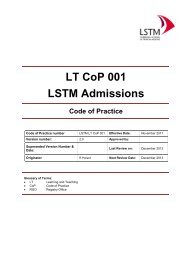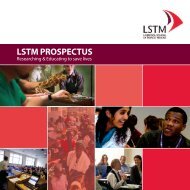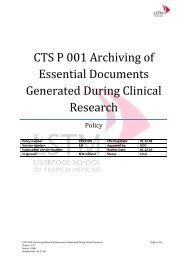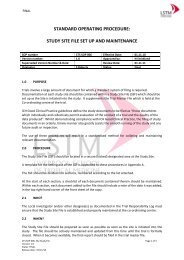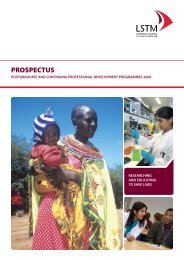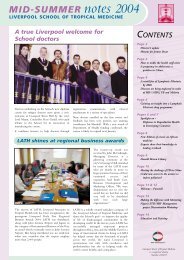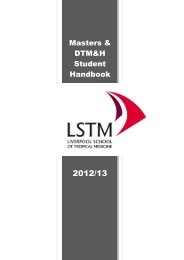Gender influences on child survival, health and nutrition: a ... - Unicef
Gender influences on child survival, health and nutrition: a ... - Unicef
Gender influences on child survival, health and nutrition: a ... - Unicef
Create successful ePaper yourself
Turn your PDF publications into a flip-book with our unique Google optimized e-Paper software.
<str<strong>on</strong>g>Gender</str<strong>on</strong>g> Influences On Child Survival, Health And Nutriti<strong>on</strong>: A Narrative Review<br />
Glossary of gender terms:<br />
Women’s status refers to the different value assigned to women <strong>and</strong> men in a socio-cultural c<strong>on</strong>text <strong>and</strong> reflects<br />
their positi<strong>on</strong> in the household <strong>and</strong> wider society. Women’s status mediates their access to opportunities <strong>and</strong><br />
resources in those c<strong>on</strong>texts as well as <str<strong>on</strong>g>influences</str<strong>on</strong>g> their ability to act aut<strong>on</strong>omously.<br />
Women’s aut<strong>on</strong>omy is related to women’s status <strong>and</strong> refers to the relative decisi<strong>on</strong>-making power women have<br />
within the household or within their wider society.<br />
<str<strong>on</strong>g>Gender</str<strong>on</strong>g> refers to the socially <strong>and</strong> culturally prescribed roles <strong>and</strong> values that are ascribed to girls <strong>and</strong> boys,<br />
women <strong>and</strong> men in different societies <strong>and</strong> c<strong>on</strong>texts. Researchers generally refer to biological sex as fixed while<br />
gender roles <strong>and</strong> relati<strong>on</strong>s are changeable. It is worth noting however that recent research has pointed to the<br />
ways in which biological sex is also changeable <strong>and</strong> is also subject to social <strong>and</strong> cultural expectati<strong>on</strong>s <strong>and</strong><br />
therefore also open to change <strong>and</strong> transformati<strong>on</strong>.<br />
<str<strong>on</strong>g>Gender</str<strong>on</strong>g> roles <strong>and</strong> relati<strong>on</strong>s refer to those ways in which women <strong>and</strong> men are taught to behave in specific ways<br />
related to their biological sex, including in terms of how they relate to <strong>on</strong>e another. <str<strong>on</strong>g>Gender</str<strong>on</strong>g> roles <strong>and</strong> relati<strong>on</strong>s<br />
are embedded in educati<strong>on</strong>, political <strong>and</strong> ec<strong>on</strong>omic systems <strong>and</strong> religi<strong>on</strong> in any given c<strong>on</strong>text.<br />
<str<strong>on</strong>g>Gender</str<strong>on</strong>g> norms, identities <strong>and</strong> values refer to those aspects underlying gender roles <strong>and</strong> relati<strong>on</strong>s. <str<strong>on</strong>g>Gender</str<strong>on</strong>g><br />
norms, identities <strong>and</strong> values in any given c<strong>on</strong>text define the underst<strong>and</strong>ing <strong>and</strong> expectati<strong>on</strong>s of women’s <strong>and</strong><br />
men’s capacities, characteristics <strong>and</strong> social behaviour within that c<strong>on</strong>text.<br />
<str<strong>on</strong>g>Gender</str<strong>on</strong>g> divisi<strong>on</strong> of labour refers to the different work assigned to women <strong>and</strong> men according to the social <strong>and</strong><br />
cultural c<strong>on</strong>text in which they are embedded.<br />
Intra-household bargaining refers to the ways in which women <strong>and</strong> men participate in <strong>and</strong> have c<strong>on</strong>trol over<br />
decisi<strong>on</strong>s about household resources. Researchers have pointed to the importance of taking into account factors<br />
affecting the relative ‘bargaining positi<strong>on</strong>’ of different household members, including women <strong>and</strong> men with<br />
different statuses within the household.<br />
INTRODUCTION<br />
<str<strong>on</strong>g>Gender</str<strong>on</strong>g> equality refers to the way in which women <strong>and</strong> men are treated according to their biological sex <strong>and</strong> the<br />
resources <strong>and</strong> opportunities to which they have access in their everyday lives. Women’s activists have sought to<br />
reduce discriminati<strong>on</strong> that leads to inequalities between women <strong>and</strong> men <strong>and</strong> which create unfair imbalances in<br />
women’s <strong>and</strong> girls (as opposed to men’s <strong>and</strong> boys’) access to resources, benefits, services <strong>and</strong> decisi<strong>on</strong>-making<br />
power.<br />
<str<strong>on</strong>g>Gender</str<strong>on</strong>g> equity makes a distincti<strong>on</strong> between the need for ‘sameness’ <strong>and</strong> ‘fairness’ in the distributi<strong>on</strong> of those<br />
resources menti<strong>on</strong>ed above. Women <strong>and</strong> men <strong>and</strong> girls <strong>and</strong> boys may require equal access to <strong>health</strong> for<br />
example, but have different <strong>health</strong> issues that require different resources. For example, <strong>health</strong> policies <strong>and</strong><br />
programmes must take into account men’s <strong>and</strong> women’s different realities in terms of women’s reproductive<br />
roles (for example in legislating for maternity <strong>and</strong> paternity leave).<br />
<str<strong>on</strong>g>Gender</str<strong>on</strong>g> analysis refers to the critical examinati<strong>on</strong> or evaluati<strong>on</strong> of an issue, problem or situati<strong>on</strong> in order to<br />
underst<strong>and</strong> the ways in which gender roles <strong>and</strong> relati<strong>on</strong>s c<strong>on</strong>tribute to specific outcomes. <str<strong>on</strong>g>Gender</str<strong>on</strong>g> analysis is<br />
undertaken both in order to produce a detailed picture of the gender aspects <strong>and</strong> dimensi<strong>on</strong>s of a given issue<br />
<strong>and</strong> to plan for potential challenges which may influence the success of a project.<br />
<str<strong>on</strong>g>Gender</str<strong>on</strong>g> sensitivity/awareness refers to the ways in which a policy, research project or interventi<strong>on</strong> has been<br />
designed to be resp<strong>on</strong>sive to/aware of the different gender roles <strong>and</strong> relati<strong>on</strong>s which mark the behaviour <strong>and</strong><br />
attitudes of participants <strong>and</strong> which may influence its outcomes.<br />
Adapted from Reeves & Baden (2000) <str<strong>on</strong>g>Gender</str<strong>on</strong>g> <strong>and</strong> Development: C<strong>on</strong>cepts <strong>and</strong> Definiti<strong>on</strong>s.<br />
Bridge Report No. 55.<br />
10




